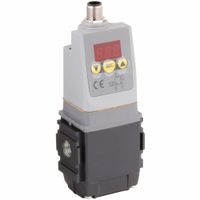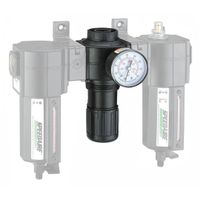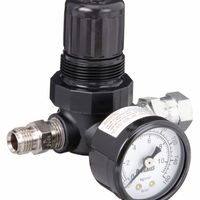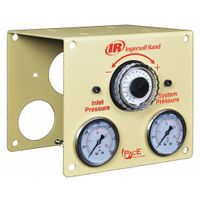Call +(254) 703 030 000 / 751 483 999 / 721 704 777
- Home
- Pneumatics
- Compressed Air Treatment
- Compressed Air Regulators
.....Read More
Frequently Asked Questions
What is the purpose of a compressed air regulator?
A compressed air regulator is a device used to control and maintain the pressure of air flowing from a compressor to various tools and equipment. Its primary purpose is to ensure that the air pressure is kept at a consistent and optimal level for the specific application, preventing damage to tools and ensuring efficient operation.
The regulator works by reducing the high pressure from the compressor to a lower, more manageable level. It consists of a pressure-reducing valve, a diaphragm, and a spring. As air enters the regulator, it passes through the valve, which adjusts to maintain the desired output pressure. The diaphragm and spring work together to sense changes in downstream pressure and adjust the valve accordingly.
By maintaining a stable air pressure, the regulator helps in prolonging the lifespan of pneumatic tools and equipment, as excessive pressure can lead to wear and tear or even failure. It also enhances safety by preventing over-pressurization, which can cause accidents or equipment damage.
Additionally, a compressed air regulator contributes to energy efficiency. By ensuring that only the necessary amount of air pressure is used, it reduces the workload on the compressor, leading to lower energy consumption and operational costs.
In summary, the purpose of a compressed air regulator is to provide consistent air pressure, protect equipment, enhance safety, and improve energy efficiency in pneumatic systems.
How do you adjust a compressed air regulator?
To adjust a compressed air regulator, follow these steps:
1. **Safety First**: Ensure the air compressor is turned off and depressurized to prevent any accidents. Wear appropriate safety gear, such as goggles and gloves.
2. **Locate the Regulator**: Identify the regulator on your air compressor. It is usually a round knob or dial located near the pressure gauge.
3. **Release Pressure**: If there is residual pressure in the system, release it by opening the air tool or valve connected to the compressor.
4. **Unlock the Regulator**: Some regulators have a locking mechanism. If yours does, unlock it by pulling up or turning a locking ring.
5. **Adjust the Pressure**: Turn the regulator knob clockwise to increase the pressure or counterclockwise to decrease it. Do this gradually while observing the pressure gauge to reach the desired pressure setting.
6. **Check the Pressure**: Once adjusted, check the pressure gauge to ensure it reads the correct pressure for your application. Make small adjustments if necessary.
7. **Lock the Regulator**: If your regulator has a locking feature, secure it by pushing down or turning the locking ring to prevent accidental changes.
8. **Test the System**: Turn on the air compressor and test the system by using the connected air tool or equipment to ensure it operates correctly at the new pressure setting.
9. **Monitor Performance**: Observe the performance of your tools or equipment to ensure they are functioning efficiently with the adjusted pressure. Make further adjustments if needed.
10. **Regular Maintenance**: Periodically check and adjust the regulator as part of routine maintenance to ensure optimal performance and longevity of your air tools and compressor.
What is an FRL in compressed air systems?
An FRL in compressed air systems stands for Filter, Regulator, and Lubricator. It is a combination of three essential components used to prepare and condition compressed air before it reaches the end-use equipment.
1. **Filter**: The filter is responsible for removing contaminants such as dust, dirt, oil, and moisture from the compressed air. This is crucial because impurities can cause wear and tear, reduce efficiency, and lead to equipment failure. Filters typically use a mesh or porous material to trap particles and may include a moisture trap to collect and drain water.
2. **Regulator**: The regulator controls the pressure of the compressed air to ensure it is at the optimal level for the specific application. It maintains a consistent output pressure despite fluctuations in the input pressure or changes in demand. This is important for the safe and efficient operation of pneumatic tools and machinery, as excessive pressure can cause damage, while insufficient pressure can lead to poor performance.
3. **Lubricator**: The lubricator adds a controlled amount of oil mist into the compressed air stream. This lubrication is necessary for certain pneumatic tools and equipment to reduce friction, prevent wear, and extend their lifespan. The lubricator ensures that the right amount of oil is delivered, avoiding over-lubrication, which can cause contamination, or under-lubrication, which can lead to increased wear.
Together, the FRL unit ensures that the compressed air is clean, at the correct pressure, and properly lubricated, enhancing the performance, reliability, and longevity of pneumatic systems. It is a critical component in maintaining the efficiency and safety of compressed air operations.
How does a compressed air regulator work?
A compressed air regulator controls the pressure of air flowing from a high-pressure source to a lower, usable pressure. It consists of several key components: a diaphragm, a spring, a valve, and a pressure adjustment knob.
When air enters the regulator, it first encounters the valve, which is connected to the diaphragm. The diaphragm is a flexible membrane that responds to pressure changes. The spring, located above the diaphragm, applies a downward force. The pressure adjustment knob allows the user to compress or decompress the spring, setting the desired outlet pressure.
As air pressure builds on the inlet side, it pushes against the diaphragm. If the pressure exceeds the set point, the diaphragm moves upward, compressing the spring and closing the valve. This action reduces the flow of air, maintaining the desired pressure on the outlet side. Conversely, if the outlet pressure drops below the set point, the spring pushes the diaphragm down, opening the valve and allowing more air to flow through until equilibrium is restored.
The regulator ensures a consistent output pressure despite fluctuations in the input pressure or changes in demand. This is crucial for applications requiring precise air pressure, such as pneumatic tools or machinery. By maintaining a stable pressure, the regulator enhances efficiency, safety, and performance in various industrial and commercial settings.
What are the benefits of using a compressed air regulator?
A compressed air regulator offers several benefits:
1. **Pressure Control**: It maintains a consistent output pressure, ensuring that tools and equipment receive the correct pressure for optimal performance, preventing damage from excessive pressure.
2. **Energy Efficiency**: By regulating the pressure, it reduces energy consumption. Lowering the pressure to the necessary level decreases the workload on the compressor, saving energy and reducing operational costs.
3. **Extended Equipment Life**: Consistent pressure reduces wear and tear on tools and machinery, extending their lifespan and reducing maintenance costs.
4. **Improved Safety**: By preventing over-pressurization, regulators enhance workplace safety, reducing the risk of equipment failure or accidents.
5. **Enhanced Performance**: Tools and equipment operate more efficiently and effectively at the correct pressure, improving productivity and quality of work.
6. **Cost Savings**: Reduced energy consumption and maintenance needs lead to significant cost savings over time.
7. **System Stability**: Regulators help maintain system stability by compensating for fluctuations in supply pressure, ensuring smooth operation.
8. **Versatility**: They allow for the use of different tools and equipment with varying pressure requirements from the same air supply system.
9. **Environmental Benefits**: By optimizing energy use and reducing waste, regulators contribute to a smaller carbon footprint.
10. **Noise Reduction**: Proper pressure regulation can reduce noise levels in pneumatic systems, contributing to a quieter work environment.
Overall, compressed air regulators are essential for efficient, safe, and cost-effective operation of pneumatic systems.
What is the difference between main line and miniature compressed air regulators?
Main line and miniature compressed air regulators serve the purpose of controlling air pressure in pneumatic systems, but they differ in size, capacity, and application.
Main Line Compressed Air Regulators:
1. **Size and Capacity**: Main line regulators are larger and designed to handle higher flow rates and pressures. They are suitable for systems requiring substantial air volume.
2. **Application**: These regulators are typically used in industrial settings where large machinery or multiple pneumatic tools are operated. They are installed at the main air supply line to regulate pressure for the entire system.
3. **Durability**: Built to withstand harsh environments and continuous operation, main line regulators are robust and durable.
4. **Features**: They often include features like pressure gauges, relief valves, and filters to ensure precise control and protection of downstream equipment.
Miniature Compressed Air Regulators:
1. **Size and Capacity**: Miniature regulators are compact and designed for low flow rates and pressures. They are ideal for applications where space is limited.
2. **Application**: Commonly used in small-scale or precision applications, such as laboratory equipment, medical devices, or small pneumatic tools.
3. **Portability**: Their small size makes them easy to install in confined spaces or portable systems.
4. **Precision**: Despite their size, miniature regulators offer precise pressure control, essential for sensitive applications.
In summary, the main difference lies in their size, capacity, and intended use. Main line regulators are suited for high-demand, industrial applications, while miniature regulators are designed for low-demand, precision tasks.
How do you maintain a compressed air regulator?
To maintain a compressed air regulator, follow these steps:
1. **Regular Inspection**: Frequently check the regulator for any visible signs of wear, damage, or leaks. Look for cracks, corrosion, or any unusual noises during operation.
2. **Cleanliness**: Keep the regulator and surrounding area clean. Dust and debris can affect performance. Use a soft brush or compressed air to remove dirt from the exterior.
3. **Check Connections**: Ensure all connections are tight and secure. Loose fittings can lead to leaks and pressure drops.
4. **Monitor Pressure Settings**: Regularly verify that the pressure settings are correct and consistent with the requirements of your system. Adjust as necessary.
5. **Drain Moisture**: If the regulator has a built-in filter or moisture trap, regularly drain any accumulated water to prevent rust and contamination.
6. **Lubrication**: Some regulators require periodic lubrication. Check the manufacturer’s guidelines for the appropriate type and frequency of lubrication.
7. **Replace Filters**: If the regulator includes a filter, replace it according to the manufacturer’s schedule or when it appears dirty or clogged.
8. **Test for Leaks**: Use a soapy water solution to test for leaks around fittings and connections. Bubbles indicate a leak that needs to be addressed.
9. **Calibration**: Periodically calibrate the regulator to ensure accurate pressure control. This may require professional servicing.
10. **Follow Manufacturer’s Guidelines**: Always adhere to the maintenance schedule and procedures recommended by the manufacturer for optimal performance and longevity.
11. **Record Keeping**: Maintain a log of maintenance activities, including inspections, repairs, and replacements, to track the regulator’s condition over time.
By following these steps, you can ensure the efficient and reliable operation of your compressed air regulator.






